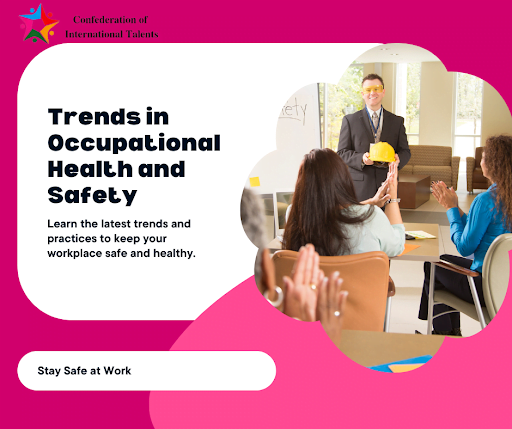Top Trends in Occupational Health and Safety Training for 2024
Occupational health and safety training has always been a critical element of maintaining a safe working environment. Workplace safety is constantly evolving. New technologies and strategies are shaping how organizations approach employee training. Let’s examine the top trends in occupational health and safety training in 2024. Staying informed about these trends can minimize risks, protect employees, and improve overall productivity.

1. Virtual reality (VR) Imitation for authentic training experiences.
One of the most notable trends in occupational health and safety training is the integration of virtual reality (VR) simulations. VR technology is an essential tool that empowers workers to practice and simulate potential workplace hazards in a secure and controlled environment. This makes them well-prepared for real-life scenarios. This also ensures that they have the necessary skills to handle any emergency.
Emergency response training can utilize VR to simulate high-pressure situations such as chemical spills, explosions, or fires that gives employees a lifelike experience and consequently enhance their preparedness and decision-making abilities. According to a study by PwC, VR-based safety training has shown a 75% reduction in workplace accidents and an overall 90% increase in retention compared to traditional training metho
2. Artificial Intelligence (AI) for Hazard Detection
AI is transforming the way we keep workplaces safe by improving hazard detection. By analyzing vast amounts of data, AI algorithms can identify potential risks and also allow for preventive measures. Let us take an example: sensors equipped with AI can detect unsafe conditions, such as elevated temperatures or hazardous gases, and alert employees and supervisors in real time. The advanced technology not only minimizes workplace accidents but also improves response times. The International Data Corporation predicts that AI-based safety systems will reduce workplace fatalities by 25% by 2024.
3. Gamification for Engaging and Interactive Training
Gamification, the application of game-like elements into non-game contexts, is gaining traction in occupational health and safety training. Interactive game-based modules motivate and engage employees in safety protocols thereby fostering active participation. Companies are utilizing gamified training platforms that incorporate features like competition, rewards, and progress tracking. Gamification example is: employees can earn points or badges as they complete the safety training module. This creates a sense of achievement and also creates a safety-conscious culture within the organization. According to a study conducted by TalentLMS, gamification can increase engagement by up to 60% and improve knowledge retention by 12%.
4. Mental Health and Wellness Programs
Many organizations are now including mental health and wellness programs as a part of their workplace safety training initiatives. The significance of mental health in the workplace is being recognized and addressed accordingly. Stress, anxiety, and depression are reported to have a significant impact on the wellness and efficiency of employees. Companies can create a healthier and more resilient workforce by addressing mental health concerns and also providing resources for support. The World Health Organization estimates that depression and anxiety cost the global economy approximately $1 trillion per year in productivity loss.
5. Mobile Learning and Microlearning
In 2024, the trend of mobile learning and microlearning is gaining significant traction in occupational health and safety training. Mobile devices provide employees with the flexibility to access training materials anytime, anywhere. Microlearning, on the other hand, involves delivering training content in short, bite-sized modules that are easy to digest and retain. Through combination of these two trends, organizations can offer on-demand training that aligns with employees’ busy schedules.
Safety apps are developed to deliver quick, interactive modules that focus on specific safety topics. These modules can include videos, quizzes, and interactive scenarios to engage employees. Mobile learning has the convenience and accessibility and microlearning’s ability to deliver essential information concisely and engagingly, significantly improves knowledge retention and thereby reinforces safety practices.
A study conducted by LEO Learning showed that mobile learning increased employee engagement levels by 35% and reduced training time by up to 45%. Implementing mobile learning and microlearning strategies can improve safety knowledge and ensure consistent training across a diverse workforce
6. Data Analytics for Predictive Safety Insights
Data analytics is emerging as a powerful tool to predict and prevent occupational hazards before they occur. It can help organizations identify potential risks and develop targeted interventions to prevent accidents and protect people.
By analyzing historical accident data along with relevant environmental factors, organizations can identify patterns and potential hotspots for accidents. This data-driven approach allows for proactive safety measures, such as implementing additional safety protocols or modifying work processes in identified high-risk areas.
Transportation companies analyze driver behavior data to identify potential unsafe driving habits. Manufacturing plants monitor equipment data to prevent unplanned downtime that could lead to accidents. As per the report by Deloitte, organizations using data analytics in their safety programs have seen up to a 30% reduction in accidents.
7. Remote and Virtual Training Solutions
The rapid advancement of technology in recent years has led to an increased focus on remote and virtual training solutions in the field of occupational health and safety. More and more people work from home therefore companies are using video conferencing, online classes, and webinars to train their employees from a distance. This helps them learn new skills and stay up-to-date with the latest information without having to be physically present in the office.
Safety training sessions can be conducted via video conferences to allow employees at different locations to participate and interact in real-time. Virtual reality (VR) and augmented reality (AR) technologies also play a significant role in remote training because it enables organizations to provide immersive safety simulations and hands-on experiences even when employees are not physically present.
The COVID-19 pandemic has accelerated the adoption of remote and virtual training solutions, but their benefits extend beyond the current circumstances. Research data indicates that organizations implementing remote training solutions have reported cost savings of up to 50% and increased training satisfaction among employees.
Conclusion:
As occupational health and safety training continues to evolve, organizations must adapt and embrace the latest trends to ensure the well-being of their employees. Top trends for 2024 include VR simulations, AI hazard detection, gamification, mental health programs, mobile microlearning, predictive analytics, and virtual training. By leveraging these advancements, organizations can minimize risks, improve safety outcomes, and create an environment of well-being in the workplace. Adopt the future of occupational health and safety training to create a safer and healthier working environment for all.
